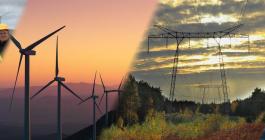Renewables Integration Assessments
The USEA JSET program is working to ensure that the Europe and Eurasia region has sufficient baseload generation and system flexibility to maintain reliability as it decarbonizes its generation fleet and adds renewable, intermittent generation capacity to the grid. JSET is leading the region’s transmission system operators and regulators in developing network models and analyses to identify future national and regional generation and flexibility capacity. The JSET program will support energy leaders in designing market-based solutions to acquire and implement that generation capacity.
USEA’s JSET Program Launches Initiatives to Accelerate Clean Energy Transition in Europe and Eurasia (January 6, 2023)
Renewable energy integration study informs Serbia energy law (November 11, 2024)
Serbia Renewable Energy Integration Study
A 2022 USEA analysis determined that Serbia can integrate considerable additional renewable energy capacity without investing in new generation for secondary and tertiary reserves. Reinforcements to existing transmission routes and new interconnections with Bosnia and Herzegovina and Montenegro will be necessary for secure system operation as additional RES is integrated. USEA recommended that the Serbian transmission system operator make legal, regulatory, and business process changes to enable more efficient RES integration and to realize wholesale price benefits. The analysis also recommended that Serbia consider new grid technologies and make reforms to its queue management system for considering connection applications.
Bosnia and Herzegovina/Croatia Sub-Regional Grid Analysis
Following a comprehensive study of renewable energy integration and transmission in Bosnia and Herzegovina, USEA recommended that the country’s transmission system operator work closely with neighboring Croatia to construct a new transmission line—and improve infrastructure on existing lines—in order to accommodate additional wind and solar generation by 2030. The report strongly recommends that network planners in both countries work together to establish cross-border cooperation and to engage in joint planning and allocation of costs for RES investments throughout the region.
QUEUE MANAGEMENT INITIATIVES
Many countries around the world face a similar challenge: the need to prioritize and rank-order all the offers they receive for connection to the high-voltage grid, particularly for clean energy. The number and size of the offers are generally far greater than the grid can accommodate and may require considerable investment in substations and in the network, which influences customer costs, transmission system planning, and the pace of renewables integration. In addition, there are congestion, balancing, import-export, and reliability issues involved in injecting such power into the existing system. Practicing good queue management to determine who should be able to connect, and in what order, is vital to maintain the health of a country’s power supply. In general, countries should follow a “first-ready, first-served” approach, rather than evaluate connection requests in the order they may have applied. Only with an efficient and transparent queue management process can transmission companies, regulators, policymakers, and other stakeholders ensure that they will meet all the current and future needs of customers for reliable, cost-effective, and clean power.
Study on Best Practices in Queue Management Worldwide
In a path-breaking study, the USEA JSET program compared the queue management process in seven countries and regions in North America and Europe with extensive experience in such connection procedures, and extracted the key lessons learned. The report summarizes dozens of queue management principles. It also makes recommendations for countries to consider as they establish and enhance their own procedures, including how to: oversee the queue management process; ensure project and transmission system operator readiness; and discourage speculative projects while clearing the queue. Every country should adapt these ideas to their local situation, laws and regulations. The USEA JSET program is actively working with countries in Southeast Europe to apply these principles and manage the queue challenge.
Related Program
Related Media
-
JUMPP Clean Energy Investment Conference
Feb 26, 2024
Related Publications
-
December 2023 - Program Publications
-
September 2022 - Program Publications
-
July 2022 - Program Publications




